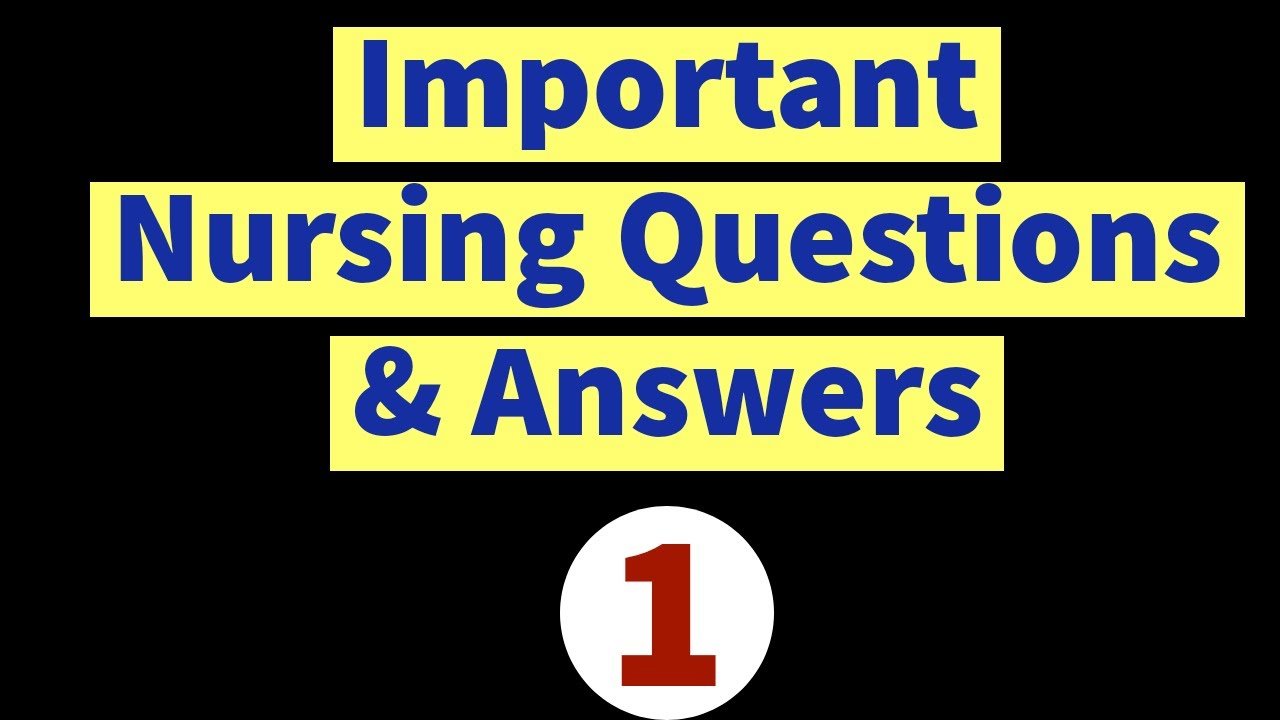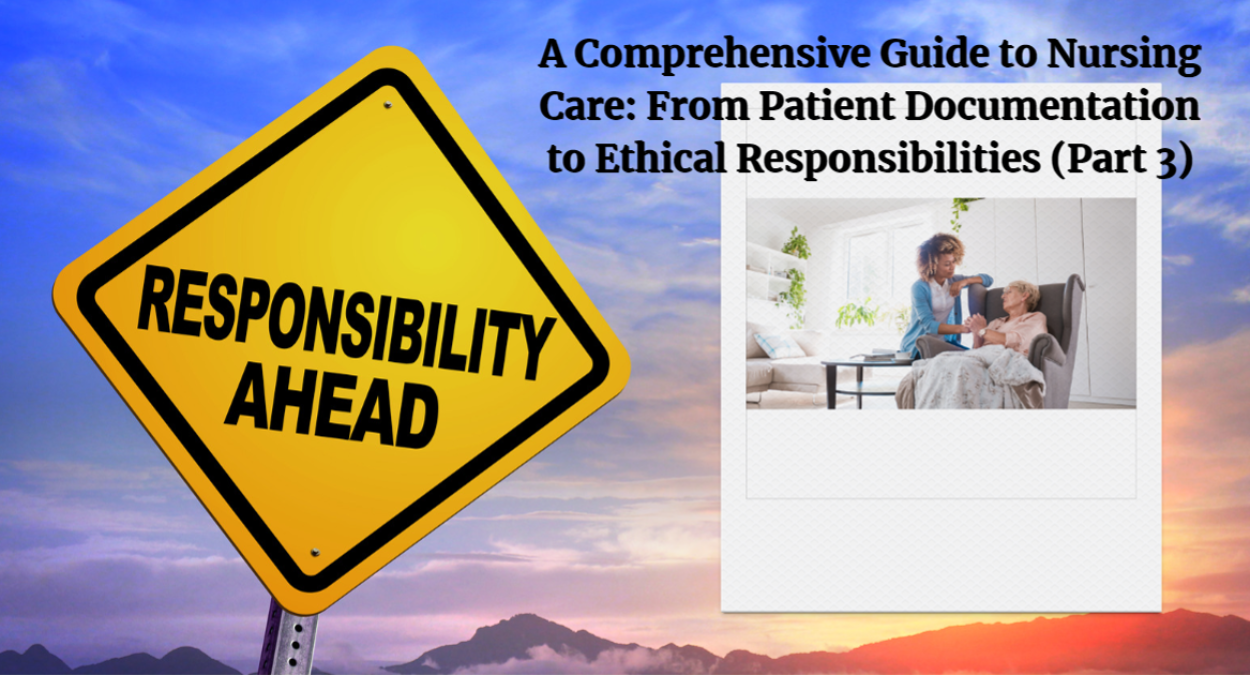All India Nursing Exam: 60 Plus Common Questions and Answers For Better Result (Part 1)
Introduction: All India Nursing Exam: 60 Plus Common Questions and Answers. Nursing is a noble profession that requires dedication, knowledge, and exceptional skills. In India, aspiring nurses have to go through rigorous examinations to prove their competency and acquire necessary certifications. The All India Nursing Exam is one such examination that evaluates the knowledge and aptitude of nursing candidates. In this article, we will explore some common questions and provide detailed answers to help you prepare for this important exam.

Question 1. What is the All India Nursing Exam?
Answer: The All India Nursing Exam is a national-level examination conducted to assess the competence of nursing candidates across the country. It is designed to evaluate their understanding of various nursing concepts, medical-surgical nursing, pediatrics, obstetrics, pharmacology, and more. The exam is an opportunity for aspiring nurses to showcase their knowledge and skills in a standardized and unbiased manner.
Question 2. Who can take the All India Nursing Exam?
Answer: The All India Nursing Exam is open to candidates who have completed their nursing education from recognized institutions in India. It is usually taken by individuals aspiring to pursue a career in nursing and wish to work in hospitals, clinics, community health centers, or other healthcare settings.
Question 3. What are the eligibility criteria for the All India Nursing Exam?
Answer: The eligibility criteria for the exam may vary slightly depending on the organizing body. However, generally, candidates must have completed their 10+2 education with Physics, Chemistry, and Biology as main subjects. They should also have a minimum aggregate percentage in their qualifying examination.
Question 4. What is the exam format?
Answer: The All India Nursing Exam is typically conducted in a multiple-choice question (MCQ) format. The exam duration, number of questions, and marking scheme may vary. Candidates are required to select the correct answer from the given options within a specified time limit.
Question 5. What are some common topics covered in the exam?
Answer: The exam covers a wide range of topics related to nursing. Some common areas include anatomy, physiology, pharmacology, pathophysiology, medical-surgical nursing, pediatric nursing, obstetric nursing, community health nursing, nursing ethics, patient education, and more. It is crucial for candidates to have a comprehensive understanding of these subjects to perform well in the exam.

Question 6. How can I prepare for the All India Nursing Exam?
Answer: Effective preparation for the All India Nursing Exam requires a combination of diligent studying and practical application. Here are some tips to help you prepare:
– Create a study schedule: Allocate dedicated time to each subject and topic, ensuring comprehensive coverage of the syllabus.
– Use study materials: Gather relevant textbooks, reference guides, and online resources to enhance your understanding of nursing concepts.
– Solve practice questions: Practice with previous years’ question papers and sample papers to familiarize yourself with the exam pattern and improve your time management skills.
– Join coaching classes: Consider joining coaching classes or online courses that specifically cater to nursing entrance exams. These resources can provide guidance, study materials, and mock tests to boost your preparation.
– Stay updated with current affairs: Keep yourself updated with recent advancements in healthcare, nursing policies, and other related topics through newspapers, journals, and online platforms.
Question 7. Are there any recommended books or study resources?
Answer: There are several books and study resources available that can aid in your preparation for the All India Nursing Exam. Some popular options include “Textbook of Medical Surgical Nursing” by Brunner and Suddarth, “Pharmacology for Nurses” by Adams and Holland, “Pediatric Nursing Made Incredibly Easy!” by Lippincott Williams & Wilkins, and “Obstetric and Gynecological Nursing” by Reeder and Martin.
Conclusion:
The All India Nursing Exam serves as a gateway for aspiring nurses to showcase their knowledge and skills. With thorough preparation and a comprehensive understanding of nursing concepts,candidates can perform well in this examination. Remember to create a study plan, practice with previous years’ question papers, and stay updated with current healthcare trends. With dedication and perseverance, you can excel in the All India Nursing Exam and embark on a fulfilling nursing career.
60 Plus Common Questions and Answers
Q: What is the normal range for adult heart rate?
A: The normal range for adult heart rate is between 60 and 100 beats per minute.
Q: What is the purpose of the Glasgow Coma Scale (GCS)?
A: The Glasgow Coma Scale is used to assess and document the level of consciousness in patients with impaired consciousness or neurological conditions.
Q: What is the recommended duration for handwashing to ensure proper hygiene?
A: The recommended duration for handwashing is at least 20 seconds with soap and water.
Q: What is the primary function of red blood cells?
A: The primary function of red blood cells is to transport oxygen from the lungs to various tissues and organs in the body.
Q: What is the purpose of the nursing process?
A: The nursing process is a systematic approach used by nurses to provide individualized and holistic care to patients. It consists of five steps: assessment, diagnosis, planning, implementation, and evaluation.
Q: What are the signs and symptoms of hypoglycemia?
A: Signs and symptoms of hypoglycemia include sweating, trembling, dizziness, confusion, weakness, hunger, and rapid heartbeat.
Q: What is the purpose of administering analgesics to a patient?
A: The purpose of administering analgesics is to relieve pain in patients.
Q: What is the role of a nurse in preventing healthcare-associated infections?
A: Nurses play a vital role in preventing healthcare-associated infections by practicing proper hand hygiene, using personal protective equipment, following infection control protocols, and educating patients and their families about infection prevention.
Q: What are the potential complications of immobility in bedridden patients?
A: Potential complications of immobility in bedridden patients include pressure ulcers, muscle atrophy, contractures, pneumonia, urinary tract infections, and deep vein thrombosis.
Q: What is the primary responsibility of a nurse in emergency situations?
A: The primary responsibility of a nurse in emergency situations is to assess and stabilize the patient’s condition, provide immediate care, and collaborate with the healthcare team to ensure timely and appropriate interventions.
Q: What is the purpose of using sterile technique during invasive procedures?
A: The purpose of using sterile technique during invasive procedures is to prevent the introduction of microorganisms into the body and reduce the risk of infection.
Q: How can nurses promote patient safety in healthcare settings?
A: Nurses can promote patient safety by accurately identifying patients, administering medications safely, preventing falls, maintaining a clean environment, effectively communicating with the healthcare team, and advocating for patient rights.
Q: What are the key principles of medication administration?
A: The key principles of medication administration include the five rights: right patient, right medication, right dose, right route, and right time.
Q: What are the potential complications of intravenous therapy?
A: Potential complications of intravenous therapy include infection at the site, phlebitis (inflammation of the vein), infiltration (leakage of fluid into surrounding tissues), air embolism, and catheter occlusion.
Q: What are the steps to perform cardiopulmonary resuscitation (CPR)?
A: The steps to perform CPR include checking for responsiveness, calling for help, initiating chest compressions, providing rescue breaths, and using an automated external defibrillator (AED) if available.
Q: What is the role of a nurse in end-of-life care?
A: The role of a nurse in end-of-life care includes providing comfort, managing symptoms, facilitating communication between the patient and their family, supporting emotional and spiritual needs, and ensuring a peaceful and dignified death.
Q: What is the purpose of using the ABCDE approach in patient assessment?
A: The ABCDE approach is used in patient assessment to prioritize and address life-threatening issues in a systematic manner. It stands for Airway, Breathing, Circulation, Disability, and Exposure.
Q: What are the common signs and symptoms of respiratory distress?
A: Common signs and symptoms of respiratory distress include shortness of breath, rapid breathing, shallow breathing, wheezing, cyanosis (blue discoloration of the lips or skin), and use of accessory muscles for breathing.
Q: What are the principles of aseptic technique in wound care?
A: The principles of aseptic technique in wound care include using sterile gloves and instruments, maintaining a sterile field, cleaning the wound with sterile solutions, using sterile dressings, and proper disposal of contaminated materials.
Q: What are the risk factors for falls in older adults?
A: Risk factors for falls in older adults include advanced age, muscle weakness, gait and balance problems, vision impairment, medication side effects, environmental hazards, and chronic health conditions such as osteoporosis or Parkinson’s disease.
Q: What is the purpose of a nursing care plan?
A: The purpose of a nursing care plan is to provide a framework for delivering individualized care to patients. It outlines the nursing diagnoses, goals, interventions, and expected outcomes for the patient’s specific healthcare needs.
Q: What are the different types of nursing documentation?
A: Different types of nursing documentation include admission assessments, progress notes, medication administration records, care plans, incident reports, and discharge summaries.
Q: What are the indications for nasogastric tube (NGT) insertion?
A: Indications for nasogastric tube insertion include gastrointestinal decompression, enteral feeding, medication administration, and gastric lavage.
Q: What is the purpose of administering anticoagulant medications?
A: The purpose of administering anticoagulant medications is to prevent or treat blood clots by inhibiting the clotting cascade and reducing the risk of thromboembolic events such as deep vein thrombosis or pulmonary embolism.
Q: What are the principles of infection control in healthcare settings?
A: The principles of infection control in healthcare settings include hand hygiene, proper use of personal protective equipment (PPE), respiratory hygiene/cough etiquette, safe handling and disposal of sharps, proper cleaning and disinfection of equipment and surfaces, and adherence to standard precautions.
Q: What are the key components of a nursing discharge teaching plan?
A: Key components of a nursing discharge teaching plan include providing information on medications, self-care activities, diet and nutrition, signs and symptoms to monitor, follow-up appointments, and when to seek medical help.
Q: What is the role of a nurse in preventing medication errors?
A: The role of a nurse in preventing medication errors includes verifying patient identification, ensuring accurate medication administration, double-checking calculations and dosages, monitoring for adverse reactions, providing patient education, and reporting any errors or near misses.
Q: What are the nursing interventions for promoting wound healing?
A: Nursing interventions for promoting wound healing include maintaining a clean and moist wound environment, proper wound cleansing, applying appropriate dressings, monitoring for signs of infection, optimizing nutrition, and promoting patient compliance with prescribed treatments.
Q: What are the potential complications of immobility in postoperative patients?
A: Potential complications of immobility in postoperative patients include decreased lung function, atelectasis (collapsed lung), deep vein thrombosis (DVT), pressure ulcers, urinary retention, constipation, and decreased muscle strength and mobility.
Q: What is the role of a nurse in managing pain in patients?
A: The role of a nurse in managing pain in patients includes assessing and documenting the patient’s pain, administering appropriate pain medications as ordered, implementing non-pharmacological pain relief strategies (such as positioning, relaxation techniques, heat or cold therapy), monitoring the effectiveness of pain interventions, educating the patient about pain management techniques, and advocating for the patient’s comfort and pain control.
Q: What are the nursing responsibilities during a blood transfusion?
A: Nursing responsibilities during a blood transfusion include verifying the blood product with another nurse, confirming the patient’s identity and blood type compatibility, monitoring the patient for signs of adverse reactions, starting the transfusion at the prescribed rate, and documenting the procedure and patient’s response.
Q: What are the signs and symptoms of sepsis?
A: Signs and symptoms of sepsis include fever or hypothermia, increased heart rate, rapid breathing, confusion or altered mental status, low blood pressure, decreased urine output, and signs of infection at the site or throughout the body.
Q: What is the role of a nurse in promoting breastfeeding?
A: The role of a nurse in promoting breastfeeding includes providing education and support to mothers, assisting with correct latch and positioning, monitoring infant feeding and weight gain, assessing for any breastfeeding difficulties, encouraging skin-to-skin contact, and referring to lactation consultants if needed.
Q: What are the potential complications of central venous catheter (CVC) insertion?
A: Potential complications of central venous catheter insertion include infection, pneumothorax (collapsed lung), catheter malposition, air embolism, thrombosis or clot formation, and catheter-related bloodstream infections.
Q: What are the principles of infection control in the operating room?
A: Principles of infection control in the operating room include maintaining strict aseptic technique, proper hand hygiene and glove use, wearing sterile attire, using sterile instruments and supplies, maintaining a sterile field, and adhering to surgical site infection prevention protocols.
Q: What are the nursing interventions for a patient with impaired mobility?
A: Nursing interventions for a patient with impaired mobility include assisting with mobility and transfers, promoting range of motion exercises, providing support devices (such as walkers or canes), ensuring a safe environment, implementing fall prevention strategies, and promoting physical therapy or rehabilitation as appropriate.
Q: What are the potential complications of diabetes mellitus?
A: Potential complications of diabetes mellitus include cardiovascular disease, diabetic neuropathy (nerve damage), diabetic retinopathy (eye damage), diabetic nephropathy (kidney damage), peripheral vascular disease, and foot ulcers.
Q: What is the role of a nurse in managing a patient with a mental health disorder?
A: The role of a nurse in managing a patient with a mental health disorder includes performing mental health assessments, administering medications as prescribed, providing therapeutic communication and support, implementing safety measures, educating the patient and their family about the condition and treatment, and collaborating with the mental health team for comprehensive care.
Q: What are the principles of ethical decision-making in nursing?
A: Principles of ethical decision-making in nursing include autonomy (respecting the patient’s right to make decisions), beneficence (acting in the patient’s best interest), nonmaleficence (avoiding harm), justice (fairness in resource allocation), veracity (truthfulness and honesty), and confidentiality (maintaining patient privacy and confidentiality).
Q: What are the nursing interventions for a patient experiencing an asthma exacerbation?
A: Nursing interventions for a patient experiencing an asthma exacerbation include assessing respiratory status, administering prescribed bronchodilators and anti-inflammatory medications, promoting proper breathing techniques, providing oxygen therapy as needed, monitoring for signs of respiratory distress, and providing education on asthma management and triggers.
Q: What are the key components of a nursing assessment for a patient with cardiovascular disease?
A: Key components of a nursing assessment for a patient with cardiovascular disease include assessing vital signs, heart rhythm, blood pressure, auscultating heart and lung sounds, evaluating peripheral pulses, assessing for signs of fluid overload or edema, reviewing medication history, and assessing for chest pain or other symptoms related to cardiac function.
Q: What is the role of a nurse in preventing healthcare-associated pressure ulcers?
A: The role of a nurse in preventing healthcare-associated pressure ulcers includes assessing the patient’s risk, implementing pressure relief strategies (such as frequent repositioning, using pressure-relieving devices), maintaining proper skin hygiene, providing adequate nutrition and hydration, and educating the patient and caregivers on pressure ulcer prevention and care.
Q: What are the principles of effective communication in nursing practice?
A: Principles of effective communication in nursing practice include active listening, using therapeutic communication techniques, providing clear and concise information, adapting communication style to the patient’s needs, showing empathy and respect, and ensuring accurate and timely documentation.
Q: What are the nursing interventions for a patient with a gastrointestinal (GI) bleed?
A: Nursing interventions for a patient with a gastrointestinal bleed include assessing vital signs and monitoring for signs of hypovolemic shock, maintaining a patent airway, administering prescribed medications (such as proton pump inhibitors or vasoactive drugs), monitoring intake and output, assessing stool color and consistency, and preparing the patient for diagnostic tests or procedures.
Q: What are the principles of medication reconciliation in nursing practice?
A: Principles of medication reconciliation in nursing practice include obtaining a complete and accurate medication history, comparing medications across transitions of care, resolving any discrepancies or conflicts, communicating medication changes to the healthcare team, educating the patient about their medications, and promoting medication adherence.
Q: What are the nursing interventions for a patient with impaired skin integrity due to immobility?
A: Nursing interventions for a patient with impaired skin integrity due to immobility include regularly assessing the skin for signs of pressure ulcers or breakdown, repositioning the patient frequently to relieve pressure, using specialized support surfaces (such as pressure-relieving mattresses or cushions), providing meticulous skin care, ensuring proper nutrition and hydration, and educating the patient and caregivers about the importance of skin protection.
Q: What is the role of a nurse in preventing healthcare-associated urinary tract infections (UTIs)?
A: The role of a nurse in preventing healthcare-associated urinary tract infections includes promoting proper catheter care and maintenance, implementing aseptic technique during catheter insertion and removal, encouraging regular voiding and bladder emptying, promoting adequate hydration, educating the patient and caregivers on hygiene practices, and monitoring for signs of UTI.
Q: What are the nursing interventions for a patient experiencing a seizure?
A: Nursing interventions for a patient experiencing a seizure include ensuring patient safety by removing any objects that could cause harm, protecting the patient’s head with padding or a pillow, turning the patient on their side to prevent aspiration, documenting the duration and characteristics of the seizure, staying with the patient and providing reassurance, and administering prescribed medications as ordered.
Q: What is the purpose of using restraints in patient care?
A: The purpose of using restraints in patient care is to ensure patient safety and prevent harm to themselves or others when other alternatives have been exhausted. Restraints should only be used as a last resort and must follow specific guidelines and regulations to protect the patient’s rights and well-being.
Q: What are the principles of delegation in nursing practice?
A: Principles of delegation in nursing practice include assessing the patient’s condition and needs, selecting appropriate tasks for delegation, communicating clearly and effectively with the healthcare team, providing proper supervision and guidance to the delegatee, ensuring the delegatee has the necessary knowledge and skills, and maintaining accountability for the delegation process.
Q: What are the nursing interventions for a patient with a suspected or diagnosed infectious disease?
A: Nursing interventions for a patient with a suspected or diagnosed infectious disease include implementing appropriate isolation precautions, practicing proper hand hygiene and infection control measures, administering prescribed medications (such as antibiotics or antivirals), monitoring vital signs and symptoms, providing comfort measures, educating the patient and caregivers about infection prevention and management, and collaborating with the healthcare team for comprehensive care.
Q: What is the role of a nurse in promoting cultural competence in healthcare?
A: The role of a nurse in promoting cultural competence in healthcare includes respecting and valuing cultural diversity, actively listening and learning from patients’ cultural beliefs and practices, providing culturally sensitive care, advocating for culturally appropriate resources and services, and promoting a safe and inclusive healthcare environment.
Q: What are the nursing interventions for a patient experiencing an anaphylactic reaction?
A: Nursing interventions for a patient experiencing an anaphylactic reaction include assessing the patient’s airway, breathing, and circulation (ABCs), administering epinephrine as a first-line treatment, maintaining a patent airway, providing oxygen therapy, monitoring vital signs, initiating intravenous fluids, and preparing for advanced life support measures if needed.
Q: What are the key components of a nursing assessment for a patient with neurological impairment?
A: Key components of a nursing assessment for a patient with neurological impairment include assessing the level of consciousness, cognitive function, motor and sensory function, reflexes, coordination, and any changes in speech or language abilities. Additionally, assessing for any signs of increased intracranial pressure, such as headache, changes in pupil size, or vomiting, is important.
Q: What are the nursing interventions for a patient with a suspected or diagnosed stroke?
A: Nursing interventions for a patient with a suspected or diagnosed stroke include assessing vital signs and neurological status, maintaining a patent airway, initiating appropriate interventions for dysphagia and aspiration prevention, administering thrombolytic medications as ordered, providing supportive care and positioning to prevent complications such as aspiration or contractures, monitoring for signs of increased intracranial pressure, and providing education and support to the patient and their family.
Q: What are the principles of effective pain management in palliative care?
A: Principles of effective pain management in palliative care include conducting a thorough pain assessment, utilizing a multimodal approach with a combination of pharmacological and non-pharmacological interventions, titrating medications to achieve adequate pain control, monitoring for side effects and adjusting medications accordingly, providing emotional support and comfort measures, and involving the patient and their family in the decision-making process.
Q: What are the nursing interventions for a patient with a compromised airway?
A: Nursing interventions for a patient with a compromised airway include assessing the patient’s airway patency, positioning the patient to maintain a patent airway, administering supplemental oxygen, providing suctioning as needed, initiating emergency airway management techniques (such as intubation or use of a bag-mask device), and monitoring oxygenation and ventilation closely.
Q: What are the key components of a nursing assessment for a patient with renal impairment?
A: Key components of a nursing assessment for a patient with renal impairment include assessing fluid and electrolyte balance, monitoring urine output and characteristics, assessing for signs and symptoms of fluid overload or dehydration, monitoring laboratory values (such as creatinine and blood urea nitrogen), evaluating dietary intake and compliance with fluid and medication restrictions, and assessing for signs of complications related to renal function, such as edema or altered mental status.
Q: What are the nursing interventions for a patient with diabetes mellitus?
A: Nursing interventions for a patient with diabetes mellitus include monitoring blood glucose levels, administering insulin or oral antidiabetic medications as prescribed, educating the patient on diabetes self-management (such as proper nutrition, exercise, and blood glucose monitoring), assessing for signs and symptoms of hypo- or hyperglycemia, promoting foot care and skin integrity, and collaborating with the healthcare team to develop an individualized care plan.
Q: What are the principles of end-of-life care in nursing practice?
A: Principles of end-of-life care in nursing practice include providing comfort measures and pain management, facilitating open and honest communication with the patient and their family, supporting emotional and spiritual needs, respecting the patient’s autonomy and wishes, assisting with advance care planning and decision-making, providing support for grief and bereavement, and promoting a peaceful and dignified dying process.
Q: What are the nursing interventions for a patient with a suspected or confirmed infection?
A: Nursing interventions for a patient with a suspected or confirmed infection include implementing appropriate isolation precautions, monitoring vital signs and symptoms, obtaining appropriate cultures for identification of the pathogen, administering prescribed antibiotics or antiviral medications, providing comfort measures, promoting rest and fluid intake, educating the patient and caregivers on infection prevention and control measures, and monitoring for signs of improvement or complications.
Q: What are the key components of a nursing assessment for a patient with a musculoskeletal injury?
A: Key components of a nursing assessment for a patient with a musculoskeletal injury include assessing the site and extent of the injury, evaluating for pain, swelling, and deformity, assessing neurovascular status (such as circulation, sensation, and movement), assessing range of motion, documenting any visible or palpable crepitus, and reviewing diagnostic imaging results. Additionally, assessing the patient’s functional abilities and providing appropriate pain management interventions are important.
https://www.proprofs.com/quiz-school/topic/nutrition
The Fascinating World of Human Physiology: Exploring the Intricacies of the Human Body (Part 2)
FAQS (Frequently Asked Questions)
Q: 1. What is the normal range for adult heart rate?
A: The normal range for adult heart rate is between 60 and 100 beats per minute.
Q: 2. What is the purpose of the Glasgow Coma Scale (GCS)?
A: The Glasgow Coma Scale is used to assess and document the level of consciousness in patients with impaired consciousness or neurological conditions.
Q: 3. What is the recommended duration for handwashing to ensure proper hygiene?
A: The recommended duration for handwashing is at least 20 seconds with soap and water.
Q: 4. What is the primary function of red blood cells?
A: The primary function of red blood cells is to transport oxygen from the lungs to various tissues and organs in the body.
Q: 5. What is the purpose of the nursing process?
A: The nursing process is a systematic approach used by nurses to provide individualized and holistic care to patients. It consists of five steps: assessment, diagnosis, planning, implementation, and evaluation.
Q: 6. What are the signs and symptoms of hypoglycemia?
A: Signs and symptoms of hypoglycemia include sweating, trembling, dizziness, confusion, weakness, hunger, and rapid heartbeat.





